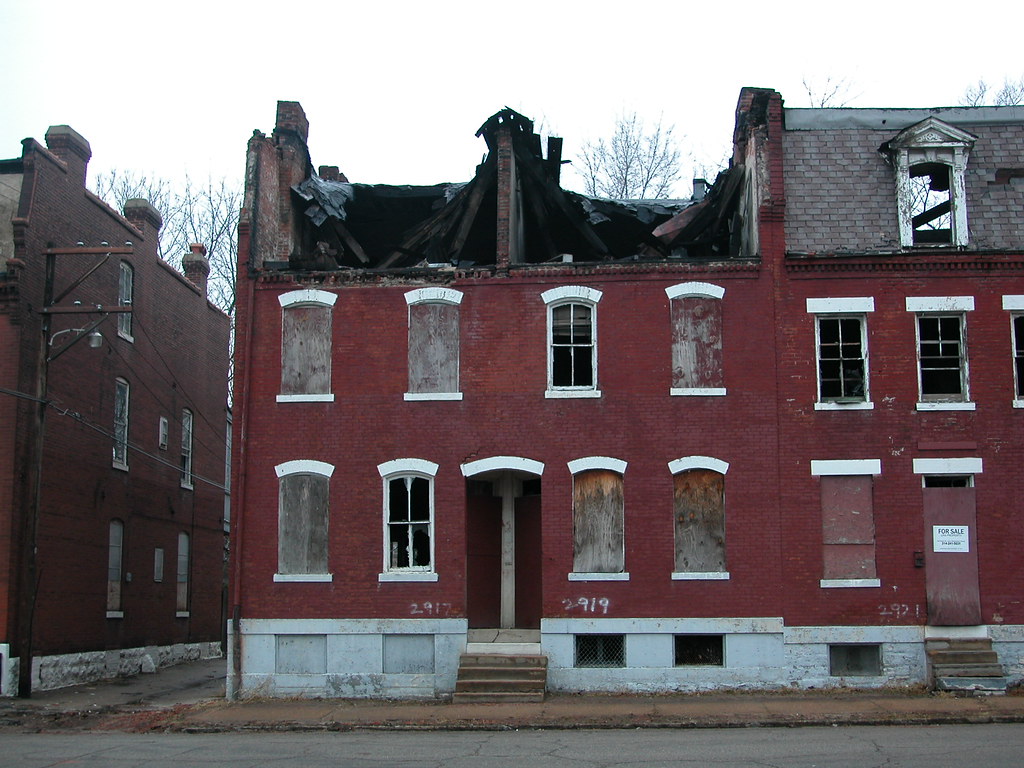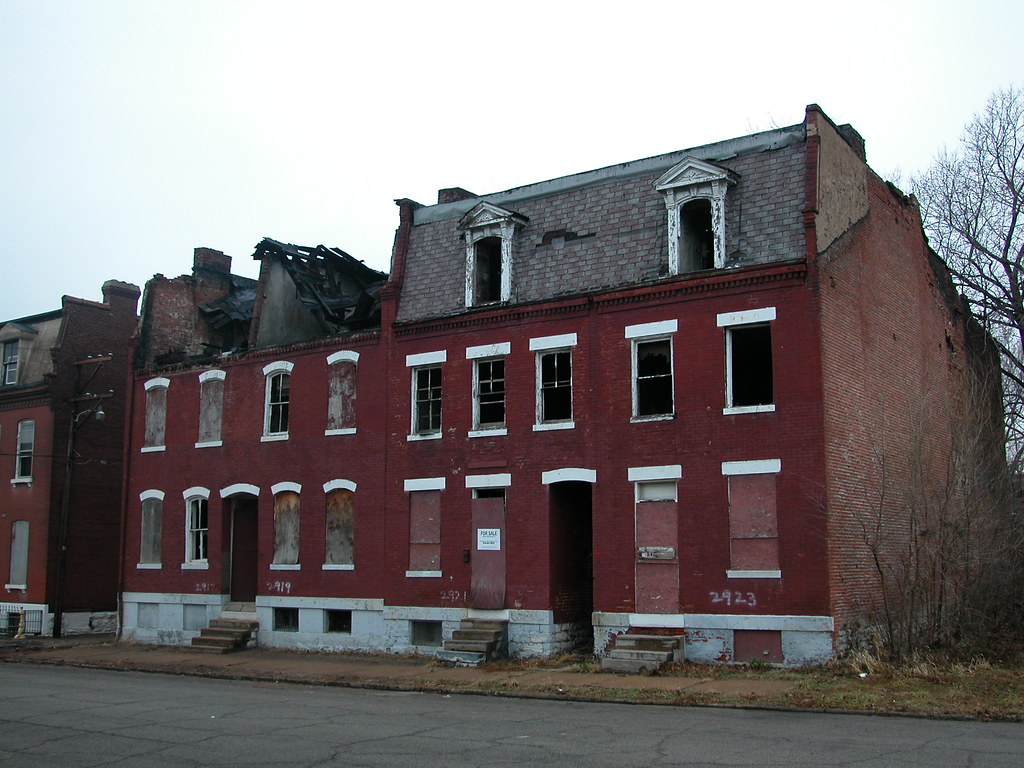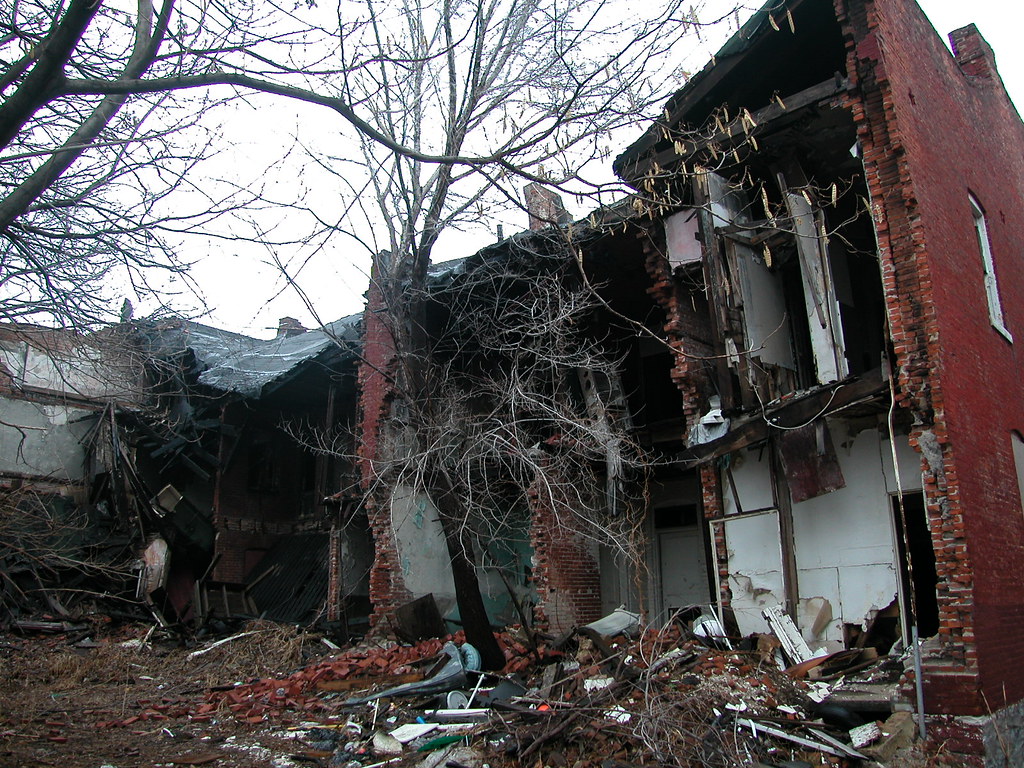
Above is the grim scene that I encountered two weeks ago after a blustery winter storm: the vacant city-owned building at 2917-21 N. 13th Street in Old North St. Louis had suffered a roof collapse. The building, built around 1880, stands one block north from my house in the densest section of a neighborhood famed for its loss of building density. Mt neighbors and I were aghast to see what misfortune had struck a vacant building already beset by misfortune.
The building and an adjacent building to the north form a graceful row that hugs the sidewalk line. Before, the buildings' back walls had fallen. Loose bricks on the parapet of the alley side elevation had caused the Land Reutilization Authority to consider emergency demolition, but LRA backed off after the Old North St. Louis Restoration Group reminded LRA that they were trying to market the poor buildings for historic rehabilitation.
Now, the mansard roof with its two dormers had completely collapsed outward and the flat roof above had fallen inside of this part of the row. But again the Restoration Group acted quickly. Development Coordinator Karen Heet fended off the Building Division and managed to get the debris out of the public right-of-way (a favorite demolition excuse) within 24 hours of the collapse.

Karen has posed a very interesting idea for reusing the buildings. A look at the rear of the row helps underscore her logic.

Rather than try to rebuild the buildings, which have lost significant building material, Karen would like to try something else. She suggests demolishing the interiors and retaining only the front and side elevations. Inside, a developer could build a new building on the old foundations using the existing brick walls as facades. The new building could be modular and modern, allowing Old North to offer a different housing unit while retaining the impressive street face of this row. I think that idea is worth attempting.
There are many historic buildings in the city with severe damage that are ineligible for historic rehabilitation tax credits. Some of these buildings are located outside of historic districts and are never going to eligible for such designation. Others are buildings that once were contributing to historic districts but have had so many sections collapse their rebuilding would count as "reconstruction" and not "rehabilitation" and thus would be ineligible for both state and federal historic rehab credits. Still others are badly remuddled old buildings that don't count as contributing resources in districts.
In such cases, a straightforward attempt at replicating the old building fabric may be cost-prohibitive or simply limiting. The old Archigram concept of using masonry walls as armaments for modular housing offers an intriguing solution to situations where we have a pretty wall and little else. In other cases, more of the original building may be retained than in others. The important thing is that we don't commit to a dichotomy in which the only common form of rehab is the tax-credit project and the only alternative is demolition for new construction. There is a full spectrum of architectural options, and saving any of the embodied energy in an old building at all is far more green than starting completely fresh.
Anyone interested in purchasing and rebuilding the buildings on 13th Street can call Karen at 314-241-5031.
More information on the row, including earlier photographs, can be found here.





5 comments:
Michael, thanks for highlighting these very important pieces of our urban fabric that (I suspect) is completely unknown to the majority of St. Louisans. Despite all our losses, we still have so much. Atlanta, Houston and all the Sunbelt boomtowns for that matter, would kill for ONE BLOCK of our magnificent housing stock. We should be proud that our simple vernacular brick rowhouses are actually works of art. We already have what other cities are so desperately trying to create.
I know I am preaching to the choir, but these scrappy survivors deserve to be preserved for another 125 years.
Great ideas.
Thank goodness for the ONSL Restoration Group. Let's hope that this building lives on in one form or another.
It would be a shame to lose them, so many have already fallen. From a practical standpoint the difficulty is at a high level. There were several buildings in similar shape, if not worse in Lafayette Square right off of the corner of Chouteau and Mississippi that were rebuilt this last year, one is still under construction on Mississippi, although that one they converted from a gable to a mansard.
In any case a combination of tax credits and the higher market rates of Lafayette Square make it possible.
From my experience with modular homes both panelized and the completed modulars, I'm just not sure there would be much of a savings over reworking what's there already.(The technical problems of converting to modular would be enormous, it might be cheaper to pull everything down and put up a similar facade)
In any case neither approach is going to be cheap and it points to the need for funding mechanisms far beyond what is now in place. And of course the real key is achieving some semblance of market rate sales, where as in Lafayette Square the cost of construction is now in step with the final value of the house.
While the buildings in Lafayette Square stood for years, the liability here is unquestionable.
One approach that has been used elsewhere is to get a roof on these buildings until a time in the future when real work can be done. If the second floor structure still supports the brickwork that approach may be feasible. Although even that would not be cheap.
It is funny that a city like St. Augustine, Florida does archaeological work on vacant building sites not much older than this one. You would think saving what is left of Old St. Louis would be a priority, but it is not.
There is an English saying, "If a building has a good hat and good boots it is a good building." In other words a building with a good roof and a sound foundation will normally be sound.
Just to expand on the idea of putting new roofs on buildings. I tried to sell the idea some years ago, but at the time government officials were not interested.
The time may be better now. $100,000 can stabilize 10 homes and maybe 15 or more, depending on condition. You may have to add on a protective construction fence in the rear these days. On the other hand $100,000 would not even completely rehab one home.
A strategy involving critical buildings would have to be in place. Maybe LRA can be cajoled into that type of work on their buildings. In any case, the building shown above should have had a roof replacement some 5 to 10 years ago or more. It would have stood for at least another few decades with a little help.
Once it gets to the stage shown it is unfortunately a steep road to make the building sound again. Not impossible, just difficult and expensive. And you never end up with quite the historic building you started with.
I just wonder what's with the rear of these buildings, is it brick rustlers causing those problems?
I am not totally clear of what the intention of the modular proposal mentioned entails. This type of modular construction may not be what you are talking about. But before this thread is totally gone I thought I would share my perspective in more detail on why modular units, while a good idea, probably won’t help in this instance. The kits run around $50 a square foot, that sounds great, but after you add the various site work needed like foundations, electric and plumbing brought into site, driveways, plus crane rental at $3000 a day to set the home, you might end up with a savings of 10 to 20% over stick build.
A project I was involved in a couple of years ago was around 10% savings if I remember correctly. Some companies claim greater savings and perhaps that is possible with short driveways, no basements etc. Please observe also no major home builder uses modular homes, if the savings were there on a consistent basis they would use the modulars if more profit could be made.
This brings us to these row houses and the additional costs they will incur if they are not rebuilt as is. First of all you would need an architect to design a custom kit house. Then remembering that the Max width of a modular unit is determined by the width of a truck, around fourteen feet, for this unit to slip into the opening between the façade and side walls of the row houses would take an operator of the crane to be a very good operator. In fact many crane operators would not undertake such a project. If the modular unit was shrunk to fit more easily, you would lose inches on the inside of the home. The modular units are built with 2x6 outside walls to withstand the handling be the crane, so you are losing a foot of interior space to start with.
If the outside brick walls are in place it would be difficult to set 2nd and 3rd stories because normally there are a few men with ladders leaning up against the building when the crane swings the module in place to help align the module with the one below.
This brings up another major problem, the deconstruction of the row house in preparation of receiving these modules. The superstructure of joists alternating each floor helps hold up the brick walls. Removing this structure means that somehow the building needs to be shored up until the modular units are put into place. If that problem is solved, you still have the tuckpointing of the building, probably inside and out, and next how to make the connection from the existing brickwork to the new modular unit.
You also have the difficulty of working around the existing structure to pour new foundations for the modular unit inside the existing foundation. (I am not clear about the statement that foundations can be reused for modular construction. No engineer would sign off on using the small shelf left over behind the existing brick work for a separate modular structure).
Finally you have the additional problem of placement of windows and doors, which are normally part of the modular unit, they couldn’t be in this case and would have to be custom installed.
I’m not saying it can’t be done, (it is a technical nightmare) I just don’t think there would be any savings, in fact it probably would be cheaper to rebuild what is there already or as I stated above, demo everything and install modular units and rebuild the old façade to match.
I do think the modular units could be used in creative ways. I’m just not sure this is the project, they would probably work better in a free standing situation.
Panelized modular construction would involve a similar discussion, although construction details would be easier to work out. If tax credits are available for a building like this it is almost impossible to ignore them given the economics of the project.
Post a Comment